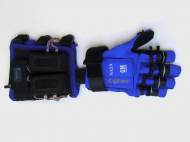Human Grasp Assist device provides additional grip force
 During the GM and NASA collaboration Robonaut 2 (R2) development, they had to engineer a dexterous hand that could use tools built for humans. That development served as groundwork for Human Grasp Assist device – a robotic glove that can be used to lower the fatigue in hand muscles after long use of tools, and thus reduce the risk of repetitive stress injuries.
During the GM and NASA collaboration Robonaut 2 (R2) development, they had to engineer a dexterous hand that could use tools built for humans. That development served as groundwork for Human Grasp Assist device – a robotic glove that can be used to lower the fatigue in hand muscles after long use of tools, and thus reduce the risk of repetitive stress injuries.
The Human Grasp Assist device, known internally in both organizations as the K-glove or Robo-Glove, weighs about 0.9 kg (2 pounds). Inspired by the finger actuation system of R2, actuators are embedded into the upper portion of the glove to provide grasping support to human fingers. The pressure sensors are incorporated into the fingertips of the glove to detect when the user is grasping a tool. Control electronics as well as a small display for programming and diagnostics are also embedded into the Robo-Glove, while an off-the-shelf lithium-ion power-tool battery with a belt-clip is used to power the system.
The first prototype of the glove was completed in March 2011 with a second generation arriving three months later. A third-generation prototype that will use repackaged components to reduce the size and weight of the system is nearing completion. The fabric for the glove was produced by Oceaneering Space Systems, the same company that provided R2’s “skin”.
“The prototype glove offers my space suit team a promising opportunity to explore new ideas, and challenges our traditional thinking of what extravehicular activity hand dexterity could be”, said Trish Petete, division chief, Crew and Thermal Systems Division, NASA Johnson Space Center.
When the user grasps the tool, the synthetic tendons automatically retract, pulling the fingers into a gripping position and holding them there until the sensor is released. This could enable an astronaut working in a pressurized suit outside the space station to lower the stress during tool operation by 2 or 3 times. The glove could also find its use in terrestrial uses in industry, military, law enforcement as well as in extreme sports.
“We are continuously looking for ways to improve safety and productivity on the shop floor. Our goal is to bring this technology to the shop floor in the near future”, said Dana Komin, manufacturing engineering director at GM, Global Automation Strategy and Execution. “When fully developed, the Robo-Glove has the potential to reduce the amount of force that an auto worker would need to exert when operating a tool for an extended time or with repetitive motions.”









Leave your response!